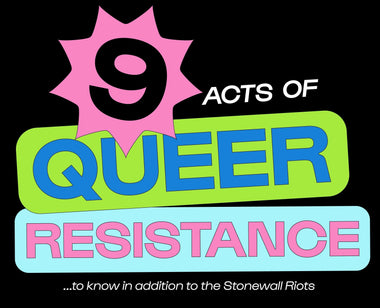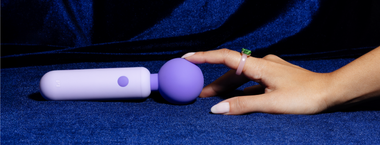Talking About Your STI Status Before Getting Intimate

CONTENTS:
- Key Concepts
- Develop a Prompt
- Integrate Your Favorite Resources
- Practice with Friends
- Disclosure Examples
- Key Takeaways
Most sex education curriculums teach students about the symptoms of STIs and how to avoid them but neglect to teach students how to engage in meaningful discussions about STIs with their partners. Media further supports sex education's teachings, or lack thereof, by failing to showcase examples of partners discussing boundaries and exchanging sexual health histories before sexual contact. When it comes to sharing something as intimate as our sexual health and STI status, elements of apprehension and stigma surface well before this initial conversation (if it happens at all).
With sex positivity becoming more accessible on social media, more people are starting to engage with questions around sex positivity's overlap with STIs. "When is the "right" time to disclose my herpes status? Do I ask someone about their STI screening history on the first date? Should I disclose that I have oral herpes to partners? How do I tell my FWB that I have a cold sore? How do I bring this up with a casual sex partner?"
Before discussing the nuances of these questions and the general how-to's of disclosure, here are a few key concepts to keep in mind:
Disclosure is mutual
Everyone has an obligation to their sexual health and sexual self. This is part of sexual self-care. This self-care includes maintaining an awareness of your STI status if engaging in sexual activities with multiple partners. Even if your most recent STI screening yielded a negative result, this does not mean you're exempt from sharing these results with your partners.
Disclosures don't just occur between sexual partners
While we mostly think of sexual health-related disclosures existing within the realm of partners, disclosing an STI status also exists outside of sexual relationships. For many, the first person they disclose to is often someone close to them, like a friend or family member. With herpes, other disclosures may exist in dental offices (oral herpes), birthing centers, or other professional spaces where skin-to-skin contact necessitates disclosure.
Yes, you can disclose via text message
Many people worry about the "right" way to disclose. While some people feel that sharing their STI status in-person is ideal, disclosing via text or dating app message can be convenient. It eliminates potential facial and body language reactions that come with rejection and eliminates any physical threat of safety in that moment. Digital disclosures also serve as a way to add in links to resources about living with your particular diagnosis. My only caution with digital disclosures, like sharing anything online, is that there is a possibility that what you share in a seemingly private space can be shared with the masses through screenshots. Overall, any disclosure, be it text or in-person, is better than no disclosure.
Don't assume someone's STI status based on appearance and/or lack of conversation around sexual health
One of the biggest assumptions we make about our sexual partners is that it will be easy to tell if someone has an STI by looking for symptoms on their genitals. This assumption is rooted in miseducation and stigma and is simply not true. While sex ed classrooms tend to disseminate photos of worst-case STI symptoms, many STIs present asymptomatically or present with minimal symptoms. The only way to know your and your partners' STI status is to get tested regularly and talk about your results with one another.
Aside from the stigma and potential rejection in sharing a positive STI status, the fear of "ruining the moment" is often the reason for avoiding conversations around sexual health altogether. It makes sense that these conversations feel awkward and unnatural since very few people were educated or introduced to navigating them. Like any skill, practice makes perfect. Below are a few examples of how to prepare for the conversation with your partners:
Develop a go-to prompt
It may take time to figure out what feels most authentic to you when initiating "the talk" with partners. Maybe you feel pressured to disclose in person and feel more comfortable over text when first integrating disclosure into your routine. Perhaps you draft a note on your phone that you can refer to as you feel more at ease with your disclosure, whether it's in-person or over text. Whatever disclosure route you decide, make it yours.
Integrate your favorite resources
It can be tempting to bombard potential partners with transmission statistics in an attempt to educate, but this can easily lead to overwhelm, especially if someone is first confronting their beliefs around STI stigma. In the last five years, increasing amounts of patient advocates and resources have become available online. I advocate mixing and matching evidence-based research (ex. Fact sheets from the CDC, WHO, ASHA, and others) with more relatable resources like Ella Dawson's TEDx Talk or my Instagram page.
Practice with friends
If you're feeling nervous about talking about your sexual health and STI status with your partners, practice with someone you trust first. Ask for their input on how they receive the message, or your body language and vocal intonation if you plan to bring it up in person. Evaluate how you felt during the exchange, and identify what might make you feel more secure in your delivery to future partners.
Disclosure Examples
There is no one-size-fits-all disclosure template, but here are a few scenarios and guides that you can make your own:
Before a date (text or dating app)
Some folks prefer to add their STI status in their dating app profile as a means to eliminate potential rejection. While this method can be efficient for some partners, it’s important to emphasize that disclosure is a mutual exchange. For example, suppose you are someone living with herpes and write "HSV+" in your dating profile. In that case, it may be easily overlooked, or someone might not know what the acronym means. Confirming your status with your partner, as well as asking for their status is important for informed consent for all parties involved.
Hey [name], I am really enjoying talking to you and find myself very attracted to you [feel free to add a specific characteristic or body part(s) you're attracted to], but I want to chat before moving forward. I have [insert STI]. I am confident in navigating it with my partners, but I understand the stigma attached to it can be overwhelming at first. Are you still interested in meeting up, or is this a bottom line for you?
From here, you can either part ways or ask about your partner's STI status and sexual health screening history.
During a date
As you're spending more time with your date, you may feel that the chemistry with this person is leaning toward a desire for sexual touch. First, establish your safety. Do you feel safe with this person? Have there been any red flags during the date that may indicate a disclosure is more appropriate over text rather than in-person? After checking in with yourself, consider where the best space is to chat. Is it on the walk to the car? Is it across the dinner table? Only you can determine your comfort level and the best space for you.
If you're reading this guide, I assume you're sex positive or are at least interested in learning more about sex positivity. Instead of immediately sharing your STI status with your date, frame your STI disclosure about their attitudes around sex positivity. This framework may also help you address any safety concerns.
After determining someone's stance, decide whether it feels safe to disclose. If you decide to move forward, link your STI status and sex positivity together.
My awareness of sex positivity has grown over the years, mainly due to my own [insert STI diagnosis]. I am someone who sees STI testing as self-care, and it helps me maintain a sense of trust with my partners. I know this is typically seen as an awkward conversation, and might be a lot to hear, so I want to check-in and see how you're feeling about this.
After a date
You felt pressure to disclose during the date but didn't feel it was the right time. Perhaps you wanted to see how the entirety of the date went before navigating a potential rejection. Like the other disclosures, it's really up to you to determine the most comfortable space to initiate the conversation (if your partner does not initiate beforehand). If you're someone living with oral herpes (aka cold sores), maybe you pause when your date moves closer to a kiss.
[Name] I've had a really wonderful time tonight, but this feels like a good time to pause. I am one of the many people living with oral herpes, commonly known as cold sores. I know some people don't disclose this, but it's important to me to help break the stigma for others and educate partners. I know it might come off as awkward, but it's important my partners are informed and aware. What are your thoughts?
Or, maybe you're someone who did not feel safe disclosing in-person after your date and prefer to touch base post-date via text message about your status.
Thanks again for a great time tonight! I really enjoyed getting to know you more and hope you feel the same. I felt it wasn't the right time to share in person, but I wanted to talk about our sexual health histories before meeting again. I have [insert STI], and know it can be challenging to be on the receiving end of this conversation. I want to check in with you about your screening history and make room for any questions you might have.
Before the Opportunity for Transmission
Ideally, disclosure occurs well before clothes are removed, but sometimes, people become caught up in the moment. While this does not excuse non-disclosure of an STI status, there is space to breathe, pause, and check in with your partners.
Hey – things are moving quickly, but we need to pause here for a moment before going further. It didn't feel like the right time to share earlier, but I can't move forward without telling you that I have [insert STI]. I know from firsthand experience that the stigma can be overwhelming, but I am open to talking about it and have navigated sex with numerous partners beforehand.
Key Takeaways
Certain language in these examples might feel too clinical or robotic for some. The beauty of these conversations is that even though it is impossible to eliminate the discomfort or fear of rejection altogether, we can create a space where we feel most empowered to find a disclosure method that feels most authentic to us.
When we think about the concept of disclosure more broadly, we all have something to share with the world. Something that excites us, a story that tested us, something that might be quirky or difficult to believe. A dream, a hope, a reason for more. I hope to one day experience a world where sex positivity, including sharing one's STI status, is as natural as sharing our favorite Netflix series with potential partners.
Emily L. Depasse is a digital creator, sex educator, and writer whose work focuses on redefining the narratives around STIs. Emily received her BA in Gender and Sexuality Studies in 2015 and will graduate with her MSW and MEd in Human Sexuality Studies from Widener University in August 2022. Her writing is featured in The Philadelphia Inquirer, The Lily, Bitch, and more. Learn more by following Emily on Instagram @sexelducation and reviewing her website.

Latest Articles

A Hot and Quick Guide to BV, UTIs, and Yeast Infections

9 Acts of Queer Resistance to Know in Addition to the Stonewall Riots








